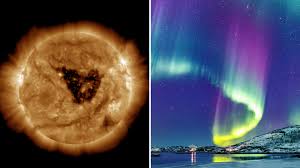A massive coronal hole on the Sun’s surface is currently releasing streams of charged particles toward Earth, heightening the potential for vivid aurora displays across high-latitude regions tonight.
Solar Winds to Trigger Geomagnetic Activity
Space weather experts report that the solar wind from this coronal hole is moving at elevated speeds, likely to interact with Earth’s magnetic field and trigger geomagnetic activity. The resulting auroras—commonly known as the northern and southern lights—may be visible in parts of Canada, Scandinavia, Alaska, and even northern Europe if skies remain clear.
Understanding Coronal Holes
Coronal holes are cooler, darker regions on the Sun’s outer layer where magnetic field lines open outward, allowing solar particles to escape more easily into space. While these events are relatively common during periods of heightened solar activity, strong streams like the current one can cause short-term disruptions to satellite communications and power grids.
NOAA Issues Geomagnetic Storm Watch
The U.S. National Oceanic and Atmospheric Administration (NOAA) has issued a geomagnetic storm watch, urging satellite operators and power providers to remain alert. Skywatchers in high-latitude areas are being advised to look northward after sunset for a possible natural light show stretching across the night sky.
A Spectacle in the Skies
If conditions align, tonight’s geomagnetic activity could produce some of the most striking auroras of the season—offering a spectacular reminder of the powerful forces linking the Sun and Earth.

